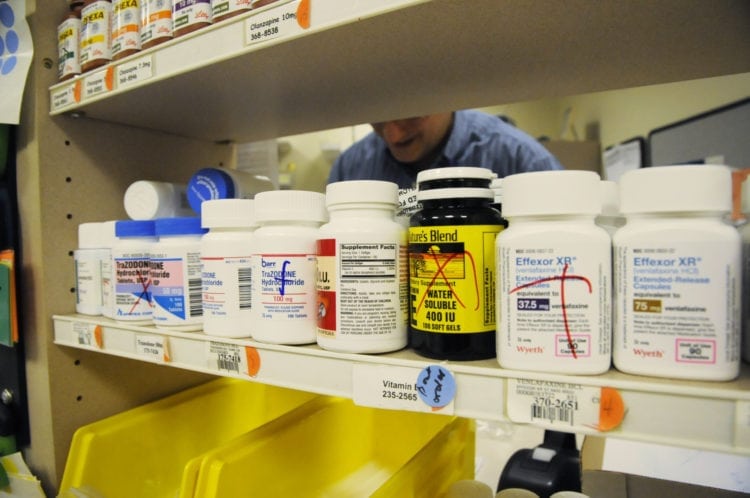Chicago Tribune investigation shows problems in drug interaction communications to patients

UW School of Pharmacy Professor John Horn and UWSOP alumnus Dan Malone were part of an investigative report, “Pharmacies miss more than half of dangerous drug combinations,” published in the Chicago Tribune on December 15, 2016. The Tribune spent months investigating how often staff at retail and independent pharmacies advised patients about the potential for serious drug interactions. The report found that the interactions were noted to the patients or their physicians in only 48% of the cases.
The Tribune investigation involved 255 pharmacies in the Chicago area. Pharmacies were presented with prescriptions for one of five pairs of drugs known to result in serious drug interactions. The prescriptions were presented by shoppers who were trained to record the pharmacy responses. The primary outcome was whether the pharmacy alerted either the patient or the physician of the potential interaction. The test drug pairs included commonly prescribed drugs such as simvastatin and clarithromycin. This combination can result in severe muscle damage and possibly renal failure in some patients.
The results from the Tribune’s reporting have been shared with the pharmacies and all are taking steps to improve the communication of possible drug interactions.
While the intent was not designed to identify the cause of the poor pharmacy response, it is generally recognized that excessive alerts for all interactions, regardless of severity, cause pharmacists, physicians and other providers to have alert fatigue and potentially missing critical warnings. Horn has worked with institutions throughout the U.S. to customize interaction alerts and avoid irrelevant alerting. Continuing education for pharmacists on drug interaction management and placing more priority on patient counseling may also provide for better patient care.
The investigative report reveals the complexity of U.S. health care delivery in the 21st century. One of the challenges comes down to the realities of the business model for most pharmacies. In almost every state, pharmacists are compensated for dispensing medications, not for the unique medication expertise that they bring to the health care team.
With the priority on dispensing medications over patient consultations, independent and chain pharmacies focus on volume to stay financially sound and are reliant on automatic alert systems. In one case, the investigation team found pharmacists were filling upward of 600 prescriptions a day with just two pharmacists working 10-hour shifts—one prescription every two minutes. With that pressure of time, pharmacists are not as able to research a patient’s health records, contact physicians, and other steps that may improve safety.
A question arises about the Tribune’s findings. Insurance plans also have systems that deny payment if a patient tries to fill a prescription that could cause a harmful drug interaction. “When that denial happens, a pharmacist will normally call the physician to request a different prescription,” notes Sean D. Sullivan, Professor and Dean of the UW School of Pharmacy. “If the Tribune investigators paid cash, then this important failsafe could not be activated.” Sullivan commented that even with that protection, pharmacies still have a vital role in the patient care process, and need to establish processes to confirm drugs are safe to dispense, especially if a patient is not insured.
As a result of decades of advocacy and education by faculty from the UW School of Pharmacy, Washington state is the first state in the U.S. in which pharmacists are compensated for providing care and expertise, not just dispensing medications. The change, which began in 2016, is taking hold in health care systems and will begin in community pharmacies in 2017.

“Pharmacists and their staff have an absolutely vital role in patient care and drug safety,” said Horn. “Based on the pairs tested in this investigation, there is no justifiable reason to not warn a patient about the dangers of interactions. I am glad to see that the pharmacies are responding so well to the report’s findings and taking steps to improve patient safety.”
Horn literally wrote the book on drug interactions. The Top 100 Drug Interactions is a mainstay for any pharmacist in practice or training. Along with co-author Philip Hansten, Horn is the recognized international authority in the field of drug-drug interactions. Together, they have more than 75 years of combined experience in the field. The drug interactions books by Dr. Hansten and Dr. Horn have been translated into 6 languages and have sold more than one million copies worldwide since 1971.
UW School of Pharmacy is a global leader on drug safety and drug interactions. From esteemed faculty like John Horn, research into geriatric, pediatric, and neonatal drug studies to resources like the Drug Interaction Database, UWSOP’s researchers advance the science, development, implementation and outcomes of safe and appropriate treatments.
###
The UW School of Pharmacy is comprised of three departments: Medicinal Chemistry, Pharmaceutics, and Pharmacy, offering Ph.D., M.S., and PharmD degrees, post docs and certificate programs.
The UW School of Pharmacy is a global leader in pharmacy education, research and service, committed to providing a transformative learning experience in a collaborative and diverse environment focused on improving the health and well-being of the communities we serve. Our mission is three-fold: inspiring education: developing exceptional, innovative and diverse pharmacy leaders and scientists; discovering solutions: advancing the science, development, implementation, and outcomes of safe and appropriate treatments; and serving people and communities: promoting the health and well-being of the public, locally and globally.